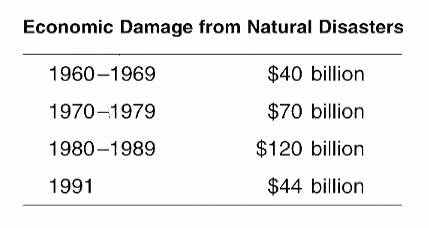Disaster Prevention
Natural Disasters and the International Decade for Natural Disaster Reduction
The Growing Damage from Natural Disasters
Natural disasters have claimed countless lives and caused enormous damage throughout history. Even today, as we approach the twenty-first century, human lives and livelihoods continue to be threatened by the ferocity of nature in such forms as storms and floods, earthquakes, tsunamis, and volcanic eruptions. There has been a conspicuous increase in the social and economic devastation caused by these disasters. Data compiled by the United Nations indicate that the economic damage caused by disasters has tripled over the past three decades (see the table).
Disasters have claimed approximately 4 million lives since the start of this century, moreover. Such recent natural disasters in developing countries as the 1991 eruption of Mt. Pinatubo in the Philippines and the massive flooding in Bangladesh in 1991 not only claimed many lives but caused serious economic and social disruption.
The industrial countries have had their share of natural disasters as well. In 1992 Hurricane Andrew left areas of Florida and Louisiana devastated.
Over the past two to three decades there has been an increase in both the frequency and scale of natural disasters. This is attributable not just to an increase in the incidence of abnormal natural phenomena but rather to the complex interaction of several factors, including explosive population growth and the resulting deterioration of housing conditions in the developing countries, as well as the impact of human activities that have magnified and aggravated the damage. These factors appear to have increased our vulnerability to disasters.

Alleviating Disasters Through International Cooperation
The total control of natural phenomena is beyond the scope of human intelligence. However, the scale of damage can vary widely according to such factors as the availability of prediction and early warning systems and the carrying out of routine efforts to raise community awareness, including the holding of evacuation drills. Damage from natural disasters may be prevented or reduced, in other words, by taking appropriate steps.
Generally speaking, natural disasters do not strike the same region time and again. For this reason, it is important to maintain concern and awareness of natural disasters during normal times. One way to maintain such awareness is to share the experiences of other countries. International cooperation in disaster prevention activities thus not only benefits the countries affected by natural disasters but also benefits donor countries by helping to raise awareness of the importance of disaster preparedness.
The issue of natural disasters must be approached on a global scale, transcending national borders and encompassing all of humanity. In this sense the International Decade for Natural Disaster Reduction (IDNDR) is expected to make a significant contribution to the field of disaster prevention by bringing together the world's wisdom and supporting the efforts of the developing countries in particular. The World Conference on Natural Disaster Reduction provides an important opportunity for the international community to make further efforts towards reducing the damage from natural disasters from a fresh perspective. It is hoped that the conference will spark additional interest of nations around the world in the activities of the IDNDR.
Back to Index
